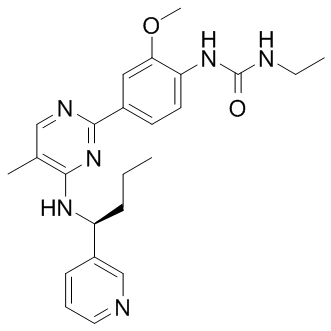All AbMole products are for research use only, cannot be used for human consumption.

CYT997, a synthetic small molecule optimized for antiproliferative activity in a panel of cell-based assays, in which the compound shows an IC50 of between 1 and 100 nmol/L across a panel of cancer cell lines. The compound inhibits the polymerization of tubulin with an IC50 of ~3 μmol/L.CYT997 causes a significant increase of cells in the G2-M phase of the cell cycle.Caspase-3 activation is also observed in cells treated with CYT997 along with the generation of poly (ADP-ribose) polymerase.CYT997 exhibits vascular disrupting activity as measured in vitro by effects on the permeability of human umbilical vein endothelial cell monolayers, and in vivo by effects on tumor blood flow. CYT997 possesses a useful combination of pharmacologic and pharmacokinetic properties and has considerable potential as a novel anticancer agent.
| Cell Experiment | |
|---|---|
| Cell lines | DU145, A549, Ramos, KHOS/NP, A375, HCT-15, HT1376, BT-20, A431, PA-1, U937, HepG2, TF-1, Baf3/TelJAK2, PC3, and K562 |
| Preparation method | Exposing the cells to various concentrations of CYT997 for ~72 hours. Assessing cell proliferation with either the Alamar blue or MTT assays. For MTT assays, adding 5 mg/mL of MTT to all wells, incubating plates for 6 hours at 37 °C, and then adding lysis buffer (10% SDS in 0.01 N HCl) and measuring absorbance at 620 nm in a BMG Technologies Lumistar or Polarstar plate reader. For Alamar blue assays, adding Alamar blue (10 μL/well) to each well and incubating the plates at 37 °C for 4 hours. Then measureing the fluorescence using a fluorescence plate reader with an excitation filter at 544 nm and an emission filter at 590 nm. For cell cycle analysis, cells are fixed and permeabilized with 70% ethanol in PBS and incubated at 4 °C overnight. RNase-treated samples (10 μg RNase/mL for 20 minutes at 37 °C) are stained with propidium iodide (5 μg/mL) at 4 °C for a minimum of 10 minutes. Cell cycle variables are determined by fluorescence-activated cell sorting (FACS) analysis using a Beckman-Coulter Quanta SC MPL system and analyzed using CXP Software. For apoptosis analysis, cells are detached and collected. Using the Vybrant Apoptosis Assay Kit to do Annexin staining . Storing cells on ice and analyzing on a Beckman Coulter Quanta MPL within 1 hour of preparation. Using two-channel analysis to determine Annexin V–positive cells . |
| Concentrations | Dissolved in DMSO, final concentrations ~1 μM |
| Incubation time | ~72 hours |
| Animal Experiment | |
|---|---|
| Animal models | Male nude mice inoculated s.c. with PC3 cells, and female BALB/c mice inoculated with 4T1 cells |
| Formulation | Formulated in NMP/PEG300/saline |
| Dosages | ~30 mg/kg/day |
| Administration | Oral gavage thrice a day |
| Molecular Weight | 434.53 |
| Formula | C24H30N6O2 |
| CAS Number | 917111-44-5 |
| Solubility (25°C) | DMSO 77 mg/mL |
| Storage |
Powder -20°C 3 years ; 4°C 2 years In solvent -80°C 6 months ; -20°C 1 month |
[5] Katherine Monaghan, et al. CYT997 causes apoptosis in human multiple myeloma
| Related Microtubule Products |
|---|
| Estramustine
Estramustine (LEO-275) is a nitrogen mustard linked to estradiol. Estramustine depolymerizes microtnbules by binding to tubulin 1, exhibits antimitotic activity with an IC50 value of ~16 μM for mitosis of DU 145 cells. Estramustine is selectively taken up by prostate cells and exerts antineoplastic effects by interfering with microtubule of dynamics and by reducing plasma levels of testosterone. |
| Nab-Paclitaxel
Nab-Paclitaxel (Nanoparticle albumin-bound Paclitaxel) is an albumin-bound nanoparticle formulation of Paclitaxel. Nab-Paclitaxel is composed of albumin and the active pharmaceutical ingredient Paclitaxel, in which human albumin is used as an excipient to disperse and stabilize particles and carry the main drug. Nab-Paclitaxel is a solvent-free taxane with higher response rates and improved tolerability. Nab-Paclitaxel displays less toxicity and greater antitumor activity. |
| CCB02
CCB02 is a selective CPAP-tubulin interaction inhibitor, binding to tubulin and competing for the CPAP binding site of β-tubulin, with an IC50 of 689 nM, and shows potent anti-tumor activity. |
| Lisavanbulin
Lisavanbulin (BAL-101553) is the prodrug of the microtubule targeting agent Avanbulin (BAL 27862). |
| 20-O-Demethyl-AP3
20-O-Demethyl-AP3 is a minor metabolite of Ansamitocin P-3. |
All AbMole products are for research use only, cannot be used for human consumption or veterinary use. We do not provide products or services to individuals. Please comply with the intended use and do not use AbMole products for any other purpose.


Products are for research use only. Not for human use. We do not sell to patients.
© Copyright 2010-2024 AbMole BioScience. All Rights Reserved.
